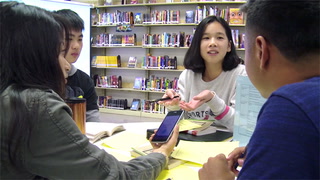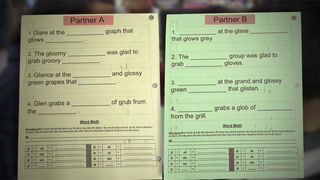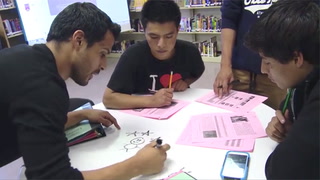Foundational Literacy Skills with Newcomers Transcript
Christopher M: My name is Christopher Maldonado. I'm the ninth and tenth grade literacy teacher at San Francisco International High School, and I teach a literacy class primarily for students with an interrupted education.
You guys ready? Let's get this going. How are you?
San Francisco International High School is a high school for recently arrived immigrants in the United States. We have a pretty diverse classroom. There are students from six different countries, three different language groups, Spanish, Arabic, and Chinese. In today's lesson we'll be focusing on building some fluency practice, phonetic awareness around consonant blends, and also working collaboratively to engage in a reading guide that we've been working on around Frieda Kahlo.
When planning this lesson, I think about strategically planning and integrating focus language study to build students' comprehension and word recognition skills together to make them skilled readers. Language comprehension's building their schema, the vocabulary, their access to the content, while word recognition is building their phonetic awareness, they're able to [inaudible 00:01:10] code, and also recognize sight words that they'll see.
Morning, guys.
Students: [crosstalk 00:01:14]
Christopher M: The first part of class is me grading them.
Guys, please take out your opening.
Students all know, when they enter class, they have an objective, an opening to do for each day.
Our opening for today says, how do you think Frieda will feel living in the United States? We are going to think about what is going to happen in the future before we read. If you guys need help, please first ask someone in your group.
Up until this day, we've been working around this theme of standing between two places and personal identity.
Can you give me a little bit more detail? Why do you think she misses Mexico?
This is their reading guide on Frieda Kahlo and understanding her experience around her home country in Mexico and transitioning to the United States.
Male Student: [inaudible 00:01:58] in Mexico.
Christopher M: That's very good.
Also building this awareness around different mediums to express personal identity, and for Frieda that was art.
You guys, we have about two more minutes. Two more minutes. James, when you are ready you can go to the computer [inaudible 00:02:11] class.
It's like giving kids options around how they can express their own story, their own identity coming to the United States.
Yeah, definitely. Or you can maybe ask Juan, too. Cool. Juan, can you help Anthony with the translation? Thank you so much.
Today, the student who had the opening was James.
James: Good afternoon, class.
Christopher M: Good afternoon, James.
James: Thank you.
Christopher M: James called on students to read the date, to read the objectives, and to read the opening.
James: Juan, can you please read the opening?
Juan: What do you think Frieda will feel living in the United States?
Christopher M: He was using ClassDojo. It's a way for students to get points for speaking English, for helping their group.
James: Can you please read that vocabulary?
Christopher M: But also, it's randomly selected, so every student's held accountable to being ready to share their opening or share their answer.
Number one, repeat after me. I miss.
Students: I miss.
Christopher M: How do I say that in Spanish?
Students: Yo extraño.
Christopher M: Very good. How about in Arabic? Omar, how do I say that in Arabic?
Omar: [Arabic 00:03:06]
Christopher M: [Darong 00:03:07], how do you say it in Chinese?
Speaker 7: Wo xiangnian.
Christopher M: Very good. We're going to be working with our groups when we're reading. We're going to be talking. We're going to say, can you explain? What did you understand? Explain in your language. Good.
I have a teaching assistant in my class. He's a former student I taught three years ago.
Male Student: It's like this, like a picture.
Christopher M: He advocated to have his 12th grade internship in my class to share his experience about being a newcomer, being a student who wasn't proficient in their native language. He wanted to come back and share his story and also work with students with similar experiences.
Today we're going to learn more about Frieda's identity, who she is in the United States, and we're going to see if our predictions are correct, so-so, or maybe it's different.
Then we started our phonics activity for the day.
These are two letters and two sounds, but we are going to blend them together.
It's a very short, brief period to build some more phonetic awareness skills. Today was around consonant blends, so G-L and G-R.
How about number three? This is a word from math class.
Male Student: Graph.
Christopher M: Graph. How do you spell graph?
Male Student: G-R-A-P-H.
Christopher M: Very good. P-H. The P-H makes the fff sound.
Male Student: Graph.
Christopher M: Graph.
Male Student: Graph.
Christopher M: Then afterwards, students engaging in some [inaudible 00:04:19] practice with the split dictation.
Partner A, you are going to read all four sentences to partner B, and you are going to put your binder up so your partner cannot see.
A split dictation is basically, students have the same text but have different words missing from those texts, so students really have to actively listen and engage to hear what their partner's reading, to write down the correct word and basically match the words together so they have a complete text after they're done.
What are some things we should be asking our partner if we do not understand?
Female Student: Can you spell?
Christopher M: Can you spell?
Male Student: Can you repeat?
Christopher M: I wrote some questions on the board for students to build their own self-awareness.
Can you repeat?
There are certain things you can do to ask your partner before asking the teacher to help you better understand what's going on or to access the content.
Please encourage, please tell your partner to say these things if they do not understand. I should only hear English during this time. Are we ready?
Male Student: Yes.
Christopher M: Very good. Partner A, you have four minutes. Go.
Students: [crosstalk 00:05:16]
Female Student: [inaudible 00:05:14]. How do you ... G-L-A ...
Male Student: Glue? Group. [inaudible 00:05:27]
Male Student: G-L. G-R-O-U-P? [inaudible 00:05:27]
Christopher M: There is an S here. Can you read this one for me one more time?
Male Student: Glass.
Christopher M: Glasses.
Male Student: Oh, glasses. Glasses.
Christopher M: Very good.
After split dictation they took out their reading guide. During the reading guide, itself, students were working in partners or groups of three to engage in some comprehension questions, more around Frieda's identity. They would read a paragraph together, ask each other, what did you understand? What I understood was this. Then work together to answer the [inaudible 00:05:54] comprehension question to make sure that they're understanding what they're reading.
Let's do a little bit of review before we start. What is Frieda's job?
Students: [crosstalk 00:06:02]
Christopher M: Painter, right? What does she describe? What does she portray or show in her paintings?
Female Student: Her experiences.
Christopher M: Her experiences? I heard-
For the reading guide section we did a whole-class review. Students ended up at different parts in the lesson, but I wanted to make sure the key ideas, the main ideas everyone got to engage with and everyone got to hear and share some input on.
It caused her a lot of what?
Female Student: Pain.
Christopher M: Pain. Today we're going to learn a little bit more about that, and we're going to learn about how Frieda became famous for being able to portray her pain in her self-portraits. Right now we're going to read with our partner. Are we going to read by ourselves or together?
Male Student: Together.
Christopher M: Good.
In terms of helping students understand what I'm trying to say, I try to be really intentional about the gestures I use. We're actively listening, we are looking up here.
What if your partner does not speak your language?
Male Student: Can you say it in your language?
Christopher M: Yeah. Even if you don't understand, we want to verbalize. We want to say our ideas. We are going to talk before we write.
Giving kids some context around not just hearing the word, but seeing a visual that might cue their understanding if they don't know what that word means. It also allows students to use those same gestures with one another. If students don't even have the language to say, oh, I understand, they can at least gesture in the same way to let their partner know, no, I got what you said, thank you.
Are we ready?
Students: Yes.
Christopher M: Good. On your mark, get set, go.
Female Student: Frieda did not paint much after she and Diego were married.
Female Student: Married, mm-hmm (affirmative).
Male Student: Diego, working was more important because he was so famous.
Christopher M: Very good. Now let's stop. What should we do first? What do you understand?
I think about, when I'm supporting these students, what other questions they need to know, or the answers they need to know before getting to that main check for understanding question in their reading guide. If a student's struggling with answering that question, what don't they actually understand? I have a list of questions I can ask to cross of things. I know they get this, I know they get that, but here's a knowledge gap that I can build.
What does Frieda like to do? She likes to what?
Female Student: Paint.
Christopher M: Paint. Was she able to paint when she was with Diego? I'm going to come back in one minute, and I want both of you to be able to answer the question.
Female Student: Okay.
Christopher M: Can you give me a paper? Can you try to draw that for me?
Male Student: Which one?
Christopher M: This idea. Can you try to visualize for me?
Male Student: Yes.
Christopher M: My favorite thing is when kids draw. It's really interesting to me to see how kids conceptualize these ideas.
Male Student: Many, many people with Diego, because he was famous. Diego painted many, many pictures. Many pictures, [inaudible 00:08:55]. You understand?
Christopher M: For me, when I see students both explaining verbally and through another medium like visualization, it really shows me that they're thinking about not only the content, but how to teach the content to someone else.
Before you do this, let's say-
Male Student: What do you understand [crosstalk 00:09:09]
Christopher M: What I understand is-
Male Student: You understand? Can you say me in your language?
Christopher M: It's like, explain in your language.
Male Student: Can [inaudible 00:09:18]?
Christopher M: Was she able to paint?
I want to be very intentional about how students use phones. It's one word or two words.
Can you translate that word for me?
In terms of language support, I think it's really important for students to have access to their native language. Oftentimes students feel discouraged because they have the idea, it's right there for them, but they can't express it in English. I also want to give them access to a tool that they can use to benefit themselves and to be able to express their ideas fully in English.
Students: [crosstalk 00:09:44]
Christopher M: Guys, can I have your attention right up here? Three.
Then after their reading guide we engage in something called a fluency test.
I know today is a short day, and it was very, very fast. Right now, quickly, can you guys put your reading guides back in your binders, and can you log onto your computers and do your fluency tests?
I use Fluency Tutor to measure and track students' fluency growth. Students take out their computer, log on through their email, and they actually have a fluency passage for me, where they record their fluency passage and I actually grade them tonight and see a more focused assessment of how they're growing in their fluency.
Male Student: She was, and did not try to change.
Female Student: She painted many self-portraits to show her feelings-
Christopher M: I'll go and see where they're inserting words, substituting words, which words they're mispronouncing. They'll get feedback the next day around their overall growth with a ground that tracks their development.
Finished? When you are done, click I'm finished, send to teacher, log out, and put your computer away.
The one thing I was really looking for today was students explaining their ideas.
Male Student: Understand?
Male Student: Yes.
Male Student: Can you-
Christopher M: The way I can tell it went really well was students were asking questions to one another about the content. Students were asking, where did you find that? Or, I understand that, too, but I think this.
Guys, thank you so much. You guys did a great job today, and I will see you guys tomorrow. Thank you.
It's hard coming to a new country, learning a new language, learning how to read. I want to make sure students feel confident in their ability, feel pride in their growth, because their growth is very different from other students' growth. I think oftentimes I just sit back and I'm so amazed because they're teaching themselves.
















6 Comments
Karol Maloney Oct 24, 2022 10:55pm
Dear Mr. Maldonado,
This was very inspiring and It fueled my excitement to become an ESL teacher.
I learned so much from the techniques you use in class. The hand gestures, the check ins, and the uplifting of each student's ability was sensational.
Thank you for all you do!
A Fellow Educator wanting to make a difference like you.
Karol Maloney, HBG PA
Tania Rodriguez Nov 15, 2019 1:39am
I was a English language learner when I started school, so seeing that there are school like this one gives me joy. I learned that there are many activities that help students learn how to read and communicate in English. I liked how he gets students to participate in class by using an application that randomly selects students because it can be hard to willingly participate when learning a new language. Do students have a class before this one where they learn the sounds of words in English, or do you teach them from the beginning?
Megan Ahern Dec 15, 2018 10:45pm
Do you create reading guide passage yourself?
Efrain Tovar Mar 19, 2018 3:38pm
Ilene Giamanco Aug 1, 2019 1:33pm
Thank you very much!
Ilene Giamanco Feb 18, 2018 11:25pm